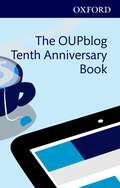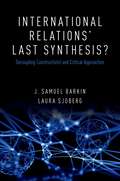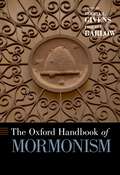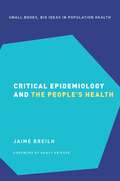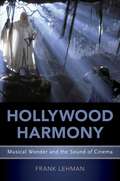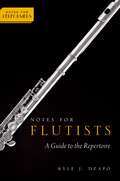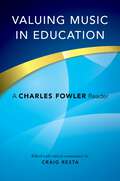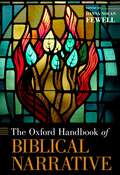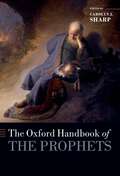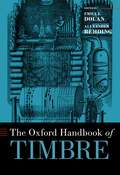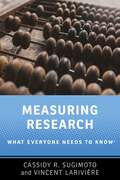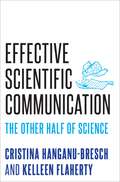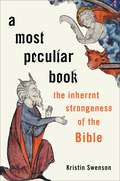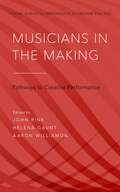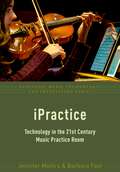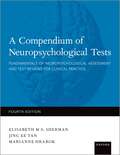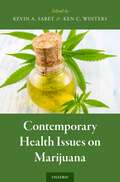- Table View
- List View
The OUPblog Tenth Anniversary Book: Ten Years of Academic Insights For the Thinking World
by Alice NorthoverThe OUPblog Tenth Anniversary Book: Ten Years of Academic Insights for the Thinking World celebrates the incisive works that made the OUPblog what it is today: an unrivaled source for sophisticated learning, understanding, and reflection. Hand-picked by Oxford University Press editors, these selections feature James M. McPherson on Lincoln's greatest moment, Arne L. Kalleberg's on police brutality in Ferguson, Missouri, and Anatoly Liberman's exploration into the origins of the word "bigot,¨among many others. From the fall of Rome and the science of happiness, to race relations and international law, the OUPblog has adapted the insights of authors, staff, and friends of Oxford University Press for an entire decade, earning its place as a 2013 Webby Award Honoree. Since 2005, more than 8,000 articles have been published, featuring daily commentary on a wide range of topics spanning politics, science, philosophy, music, and everything in between. Today, the OUPblog continues to represent the Oxford University Press's commitment to excellence in research, scholarship, and education, disseminating insights from the world's greatest thinkers.
International Relations' Last Synthesis?: Decoupling Constructivist and Critical Approaches
by J. Samuel Barkin Laura SjobergMany scholars, intentionally or unintentionally, have entangled constructivisms and critical theories in problematic ways, either by assigning a critical-theoretical politics to constructivisms or by assuming the appropriateness of constructivist epistemology and methods for critical theorizing. IR's Last Synthesis? makes the argument that these connections mirror IR's grand theoretical syntheses of the 1980s and 1990s and have similar constraining effects on the possibilities of IR theory. They have been made without adequate reflection, in contradiction to the base assumptions of each theoretical perspective, and to the detriment of both knowledge accumulation about global politics and theoretical rigor in disciplinary IR. It is not that constructivisms and critical theories have no common ground; rather, the fact that it has become routine for IR scholars to overstate their common ground is counterproductive to the discovery and utilization of their potential dialogues. To that end, IR's Last Synthesis? argues that scholars using the two in conjunction should be cognizant of, rather than gloss over, the tensions between the approaches and the tools they have to offer. Along these lines, the book uses the concept of affordances to look at what each has to offer the other, and to argue for a modest, reflective, specified return to (constructivist and critical) IR theorizing. By rejecting its over-simple syntheses, this book hews a road toward reviving IR theorizing.
International Relations' Last Synthesis?: Decoupling Constructivist and Critical Approaches
by J. Samuel Barkin Laura SjobergMany scholars, intentionally or unintentionally, have entangled constructivisms and critical theories in problematic ways, either by assigning a critical-theoretical politics to constructivisms or by assuming the appropriateness of constructivist epistemology and methods for critical theorizing. IR's Last Synthesis? makes the argument that these connections mirror IR's grand theoretical syntheses of the 1980s and 1990s and have similar constraining effects on the possibilities of IR theory. They have been made without adequate reflection, in contradiction to the base assumptions of each theoretical perspective, and to the detriment of both knowledge accumulation about global politics and theoretical rigor in disciplinary IR. It is not that constructivisms and critical theories have no common ground; rather, the fact that it has become routine for IR scholars to overstate their common ground is counterproductive to the discovery and utilization of their potential dialogues. To that end, IR's Last Synthesis? argues that scholars using the two in conjunction should be cognizant of, rather than gloss over, the tensions between the approaches and the tools they have to offer. Along these lines, the book uses the concept of affordances to look at what each has to offer the other, and to argue for a modest, reflective, specified return to (constructivist and critical) IR theorizing. By rejecting its over-simple syntheses, this book hews a road toward reviving IR theorizing.
The Oxford Handbook of Mormonism (Oxford Handbooks)
by Terryl L. Givens and Philip L. BarlowWinner of the Best Anthology Book Award from the John Whitmer Historical Association Winner of the Special Award for Scholarly Publishing from the Association for Mormon Letters Scholarly interest in Mormon theology, history, texts, and practices--what makes up the field now known as Mormon studies--has reached unprecedented levels, making it one of the fastest-growing subfields in religious studies. In this volume, Terryl Givens and Philip Barlow, two leading scholars of Mormonism, have brought together 45 of the top experts in the field to construct a collection of essays that offers a comprehensive overview of scholarship on Mormons. The book begins with a section on Mormon history, perhaps the most well-developed area of Mormon studies. Chapters in this section deal with questions ranging from how Mormon history is studied in the university to the role women have played over time. Other sections examine revelation and scripture, church structure and practice, theology, society, and culture. The final two sections look at Mormonism in a larger context. The authors examine Mormon expansion across the globe--focusing on Mormonism in Latin America, the Pacific, Europe, and Asia--in addition to the interaction between Mormonism and other social systems, such as law, politics, and other faiths. Bringing together an impressive body of scholarship, this volume reveals the vast range of disciplines and subjects where Mormonism continues to play a significant role in the academic conversation. The Oxford Handbook of Mormonism will be an invaluable resource for those within the field, as well as for people studying the broader, ever-changing American religious landscape.
Critical Epidemiology and the People's Health (Small Books Big Ideas in Population Health)
by Jaime BreilhAn indispensable read for all those seeking to address the severe problems of local and global human health and environmental crises The widespread growth of monopolies and big business has led to a fourth industrial revolution focused on producing fast, living fast, and dying fast for the sole benefit of accelerated profit. Despite unprecedented accumulations of wealth and industry, the world has watched as indicators of income inequality--a partial parameter of social inequity--have increased, while big business, with their nearly unrestricted influence, has increasingly distorted advancements in medical research. Bold and incisive, Critical Epidemiology and the People's Health invites readers to the next great paradigm in public health by promoting a progressive, transdisciplinary, intercultural, community-building approach radically divergent from the presiding object-based, empiricist mode of thinking. A concise overview of the Latin American Social Medicine movement, this book introduces the work of leading scientist Jaime Breilh to a global English audience, focusing on key questions such as: What are the real challenges facing critical epidemiology during the current time of immense turmoil and inequity? How can we conduct responsible and sensitive public health research? What role does epidemiology play in addressing the societal ills of both the global North and South? And how can we create a more rigorous, updated, and effective epidemiology? In addressing these questions, Critical Epidemiology and the People's Health offers readers a clear-eyed and much-needed perspective on how to overcome Cartesian reductionism with renewed methodological tools to address the rampant growth of injustices harming our global collective health and to subvert the reigning notions of health prevention and promotion.
Critical Epidemiology and the People's Health (Small Books Big Ideas in Population Health)
by Jaime BreilhAn indispensable read for all those seeking to address the severe problems of local and global human health and environmental crises The widespread growth of monopolies and big business has led to a fourth industrial revolution focused on producing fast, living fast, and dying fast for the sole benefit of accelerated profit. Despite unprecedented accumulations of wealth and industry, the world has watched as indicators of income inequality--a partial parameter of social inequity--have increased, while big business, with their nearly unrestricted influence, has increasingly distorted advancements in medical research. Bold and incisive, Critical Epidemiology and the People's Health invites readers to the next great paradigm in public health by promoting a progressive, transdisciplinary, intercultural, community-building approach radically divergent from the presiding object-based, empiricist mode of thinking. A concise overview of the Latin American Social Medicine movement, this book introduces the work of leading scientist Jaime Breilh to a global English audience, focusing on key questions such as: What are the real challenges facing critical epidemiology during the current time of immense turmoil and inequity? How can we conduct responsible and sensitive public health research? What role does epidemiology play in addressing the societal ills of both the global North and South? And how can we create a more rigorous, updated, and effective epidemiology? In addressing these questions, Critical Epidemiology and the People's Health offers readers a clear-eyed and much-needed perspective on how to overcome Cartesian reductionism with renewed methodological tools to address the rampant growth of injustices harming our global collective health and to subvert the reigning notions of health prevention and promotion.
Hollywood Harmony: Musical Wonder and the Sound of Cinema (Oxford Music/Media Series)
by Frank LehmanFilm music often tells us how to feel, but it also guides us how to hear. Filmgoing is an intensely musical experience, one in which the soundtrack structures our interpretations and steers our emotions. Hollywood Harmony explores the inner workings of film music, bringing together tools from music theory, musicology, and music psychology in this first ever book-length analytical study of this culturally central repertoire. Harmony, and especially chromaticism, is emblematic of the "film music sound," and it is often used to evoke that most cinematic of feelings-wonder. To help parse this familiar but complex musical style, Hollywood Harmony offers a first-of-its kind introduction to neo-Riemannian theory, a recently developed and versatile method of understanding music as a dynamic and transformational process, rather than a series of inert notes on a page. This application of neo-Riemannian theory to film music is perfect way in for curious newcomers, while also constituting significant scholarly contribution to the larger discipline of music theory. Author Frank Lehman draws from his extensive knowledge of cinematic history with case-studies that range from classics of Golden Age Hollywood to massive contemporary franchises to obscure cult-films. Special emphasis is placed on scores for major blockbusters such as Lord of the Rings, Star Wars, and Inception. With over a hundred meticulously transcribed music examples and more than two hundred individual movies discussed, Hollywood Harmony will fascinate any fan of film and music.
HOLLYWOOD HARMONY OMMS C: Musical Wonder and the Sound of Cinema (Oxford Music/Media Series)
by Frank LehmanFilm music often tells us how to feel, but it also guides us how to hear. Filmgoing is an intensely musical experience, one in which the soundtrack structures our interpretations and steers our emotions. Hollywood Harmony explores the inner workings of film music, bringing together tools from music theory, musicology, and music psychology in this first ever book-length analytical study of this culturally central repertoire. Harmony, and especially chromaticism, is emblematic of the "film music sound," and it is often used to evoke that most cinematic of feelings-wonder. To help parse this familiar but complex musical style, Hollywood Harmony offers a first-of-its kind introduction to neo-Riemannian theory, a recently developed and versatile method of understanding music as a dynamic and transformational process, rather than a series of inert notes on a page. This application of neo-Riemannian theory to film music is perfect way in for curious newcomers, while also constituting significant scholarly contribution to the larger discipline of music theory. Author Frank Lehman draws from his extensive knowledge of cinematic history with case-studies that range from classics of Golden Age Hollywood to massive contemporary franchises to obscure cult-films. Special emphasis is placed on scores for major blockbusters such as Lord of the Rings, Star Wars, and Inception. With over a hundred meticulously transcribed music examples and more than two hundred individual movies discussed, Hollywood Harmony will fascinate any fan of film and music.
Notes for Flutists: A Guide to the Repertoire (Notes for Performers)
by Dr. Kyle DzapoNotes for Flutists: A Guide to the Repertoire offers important historical and analytical information about three dozen of the best-known pieces written for the instrument. Its contextual and theoretical insights make it an essential resource for professional, amateur, and student flutists. With engaging prose supported by fact-filled analytical charts, the book offers rich biographical information and informative analyses to help flutists gain a more complete understanding of J. S. Bach's Sonata in B minor, Reinecke's Undine Sonata, Fauré's Fantaisie, Hindemith's Sonata for Flute and Piano, Copland's Duo for Flute and Piano, and 30 other masterpieces. Offering a faithful and comprehensive guide to understanding the contexts in which the repertoire was composed, Notes for Flutists details in clear, chronological order flute repertoire from Telemann, Mozart, and Enescu to Prokofiev, Poulenc, and Muczynski. Kyle Dzapo includes biographical information on each composer and highlights history's impact on the creation and performance of important works for flute. Intended as a starting point for connecting performance studies with scholarship, Dr. Dzapo's analysis will help flutists gain a more complete picture of a given work. Its valuable insights make it essential to musicians preparing and presenting programs, and its detailed historical information about the work and composer will encourage readers to explore other works in a similarly analytical way. Covering concertos, chamber pieces, and works for solo flute, Kyle Dzapo presents Notes for Flutists, an indispensable handbook for students and professionals alike.
Valuing Music in Education: A Charles Fowler Reader
by Craig RestaNoted music education and arts activist Charles Fowler has inspired music educators for more than 60 years. In this book, editor Craig Resta brings together the most important of Fowler's writings from the journal Musical America for new generations of readers. Here, Fowler speaks to many timeless issues including creativity and culture in the classroom, school funding, reform and policy, assessment and pedagogy, and equality and pluralism in music education. The articles are both research-based and practical, and helpful for many of the most important concerns in school-based advocacy and scholarly inquiry today. Resta offers critical commentary with compelling background to these enduring pieces, placing them in a context that clarifies the benefit of their message to music and arts education. Fowler's words speak to all who have a stake in music education: students, teachers, parents, administrators, performers, community members, business leaders, arts advocates, scholars, professors, and researchers alike. Valuing Music in Education is ideal for everyone who understands the critical role of music in schools and society.
The Oxford Handbook of Biblical Narrative (Oxford Handbooks)
by Danna Nolan FewellComprised of contributions from scholars across the globe, The Oxford Handbook of Biblical Narrative is a state-of-the-art anthology, offering critical treatments of both the Bible's narratives and topics related to the Bible's narrative constructions. The Handbook covers the Bible's narrative literature, from Genesis to Revelation, providing concise overviews of literary-critical scholarship as well as innovative readings of individual narratives informed by a variety of methodological approaches and theoretical frameworks. The volume as a whole combines literary sensitivities with the traditional historical and sociological questions of biblical criticism and puts biblical studies into intentional conversation with other disciplines in the humanities. It reframes biblical literature in a way that highlights its aesthetic characteristics, its ethical and religious appeal, its organic qualities as communal literature, its witness to various forms of social and political negotiation, and its uncanny power to affect readers and hearers across disparate time-frames and global communities.
The Oxford Handbook of the Prophets (Oxford Handbooks)
by Carolyn J. SharpThe Latter Prophets--Isaiah, Jeremiah, Ezekiel, and the Book of the Twelve--comprise a fascinating collection of prophetic oracles, narratives, and vision reports from ancient Israel and Judah. Spanning centuries and showing evidence of compositional growth and editorial elaboration over time, these prophetic books offer an unparalleled view into the cultural norms, theological convictions, and political disputes of Israelite communities caught in the maelstrom of militarized conflicts with the empires of ancient Egypt, Babylonia, and Persia. Instructive for scholar and student alike, The Oxford Handbook of the Prophets features wide-ranging discussion of ancient Near Eastern social and cultic contexts; exploration of focused topics such as the persona of the prophet and the problem of violence in prophetic rhetoric; sophisticated historical and literary analysis of key prophetic texts; issues in reception history, from these texts' earliest reinterpretations at Qumran to Christian appropriations in contemporary homiletics; feminist, materialist, and postcolonial readings engaging the insights of influential contemporary theorists; and more. The diversity of interpretive approaches, clarity of presentation, and breadth of expertise represented here will make this Handbook indispensable for research and teaching on the Latter Prophets.
The Oxford Handbook of Timbre (Oxford Handbooks)
by Emily I. Dolan Alexander RehdingDespite its importance as a central feature of musical sounds, timbre has rarely stood in the limelight. First defined in the eighteenth century, denigrated during the nineteenth, the concept of timbre came into its own during the twentieth century and its fascination with synthesizers and electronic music-or so the story goes. But in fact, timbre cuts across all the boundaries that make up musical thought-combining scientific and artistic approaches to music, material and philosophical aspects, and historical and theoretical perspectives. Timbre challenges us to fundamentally reorganize the way we think about music. The twenty-five essays that make up this collection offer a variety of engagements with music from the perspective of timbre. The boundaries are set as broad as possible: from ancient Homeric sounds to contemporary sound installations, from birdsong to cochlear implants, from Tuvan overtone singing to the tv show The Voice, from violin mutes to Moog synthesizers. What unifies the essays across this vast diversity is the material starting point of the sounding object. This focus on the listening experience is radical departure from the musical work that has traditionally dominated musical discourse since its academic inception in late-nineteenth-century Europe. Timbre remains a slippery concept that has continuously demanded more, be it more precise vocabulary, a more systematic theory, or more rigorous analysis. Rooted in the psychology of listening, timbre consistently resists pinning complete down. This collection of essays provides an invitation for further engagement with the range of fascinating questions that timbre opens up.
The Oxford Handbook of Timbre (Oxford Handbooks)
by Emily I. Dolan Alexander RehdingDespite its importance as a central feature of musical sounds, timbre has rarely stood in the limelight. First defined in the eighteenth century, denigrated during the nineteenth, the concept of timbre came into its own during the twentieth century and its fascination with synthesizers and electronic music-or so the story goes. But in fact, timbre cuts across all the boundaries that make up musical thought-combining scientific and artistic approaches to music, material and philosophical aspects, and historical and theoretical perspectives. Timbre challenges us to fundamentally reorganize the way we think about music. The twenty-five essays that make up this collection offer a variety of engagements with music from the perspective of timbre. The boundaries are set as broad as possible: from ancient Homeric sounds to contemporary sound installations, from birdsong to cochlear implants, from Tuvan overtone singing to the tv show The Voice, from violin mutes to Moog synthesizers. What unifies the essays across this vast diversity is the material starting point of the sounding object. This focus on the listening experience is radical departure from the musical work that has traditionally dominated musical discourse since its academic inception in late-nineteenth-century Europe. Timbre remains a slippery concept that has continuously demanded more, be it more precise vocabulary, a more systematic theory, or more rigorous analysis. Rooted in the psychology of listening, timbre consistently resists pinning complete down. This collection of essays provides an invitation for further engagement with the range of fascinating questions that timbre opens up.
Measuring Research: What Everyone Needs to Know® (What Everyone Needs To Know®)
by Cassidy R. Sugimoto Vincent LarivièrePolicy makers, academic administrators, scholars, and members of the public are clamoring for indicators of the value and reach of research. The question of how to quantify the impact and importance of research and scholarly output, from the publication of books and journal articles to the indexing of citations and tweets, is a critical one in predicting innovation, and in deciding what sorts of research is supported and whom is hired to carry it out. There is a wide set of data and tools available for measuring research, but they are often used in crude ways, and each have their own limitations and internal logics. Measuring Research: What Everyone Needs to Know® will provide, for the first time, an accessible account of the methods used to gather and analyze data on research output and impact. Following a brief history of scholarly communication and its measurement -- from traditional peer review to crowdsourced review on the social web -- the book will look at the classification of knowledge and academic disciplines, the differences between citations and references, the role of peer review, national research evaluation exercises, the tools used to measure research, the many different types of measurement indicators, and how to measure interdisciplinarity. The book also addresses emerging issues within scholarly communication, including whether or not measurement promotes a "publish or perish" culture, fraud in research, or "citation cartels." It will also look at the stakeholders behind these analytical tools, the adverse effects of these quantifications, and the future of research measurement.
Measuring Research: What Everyone Needs to Know® (What Everyone Needs To Know®)
by Cassidy R. Sugimoto Vincent LarivièrePolicy makers, academic administrators, scholars, and members of the public are clamoring for indicators of the value and reach of research. The question of how to quantify the impact and importance of research and scholarly output, from the publication of books and journal articles to the indexing of citations and tweets, is a critical one in predicting innovation, and in deciding what sorts of research is supported and whom is hired to carry it out. There is a wide set of data and tools available for measuring research, but they are often used in crude ways, and each have their own limitations and internal logics. Measuring Research: What Everyone Needs to Know® will provide, for the first time, an accessible account of the methods used to gather and analyze data on research output and impact. Following a brief history of scholarly communication and its measurement -- from traditional peer review to crowdsourced review on the social web -- the book will look at the classification of knowledge and academic disciplines, the differences between citations and references, the role of peer review, national research evaluation exercises, the tools used to measure research, the many different types of measurement indicators, and how to measure interdisciplinarity. The book also addresses emerging issues within scholarly communication, including whether or not measurement promotes a "publish or perish" culture, fraud in research, or "citation cartels." It will also look at the stakeholders behind these analytical tools, the adverse effects of these quantifications, and the future of research measurement.
Effective Scientific Communication: The Other Half of Science
by Cristina Hanganu-Bresch Kelleen FlahertyWriting and the sciences are intricately linked. Without writing, science would not exist -- and could not be funded, communicated, replicated, enhanced, or applied. Further, writing helps scientists (and students) understand the science, explain the results of research in a greater context, and develop new ideas. Working from this philosophy, this book primarily addresses undergraduate STEM majors and minors who want or need to improve their scientific writing skills. Grounded in the basics of rhetorical research and scientific writing practices and guided by the authors' experiences in the classroom, this book makes the case that writing is an essential component of science regardless of the stage of the scientific process, and that it is in fact a component of thinking about science itself. Featuring student-centered stories that place each topic in context and suggestions for practice, Hanganu-Bresch and Flaherty arm STEM students with the skills to enhance critical thinking and cultivate good writing habits.
Effective Scientific Communication: The Other Half of Science
by Cristina Hanganu-Bresch Kelleen FlahertyWriting and the sciences are intricately linked. Without writing, science would not exist -- and could not be funded, communicated, replicated, enhanced, or applied. Further, writing helps scientists (and students) understand the science, explain the results of research in a greater context, and develop new ideas. Working from this philosophy, this book primarily addresses undergraduate STEM majors and minors who want or need to improve their scientific writing skills. Grounded in the basics of rhetorical research and scientific writing practices and guided by the authors' experiences in the classroom, this book makes the case that writing is an essential component of science regardless of the stage of the scientific process, and that it is in fact a component of thinking about science itself. Featuring student-centered stories that place each topic in context and suggestions for practice, Hanganu-Bresch and Flaherty arm STEM students with the skills to enhance critical thinking and cultivate good writing habits.
A Most Peculiar Book: The Inherent Strangeness of the Bible
by Kristin SwensonThe Bible, we are constantly reminded, is the best-selling book of all time. It is read with intense devotion by hundreds of millions of people, stands as authoritative for Judaism and Christianity, and informs and affects the politics and lives of the religious and non-religious around the world. But how well do we really know it? The Bible is so familiar, so ubiquitous that we have begun to take our knowledge of it for granted. The Bible many of us think we know is a pale imitation of the real thing. In A Most Peculiar Book, Kristin Swenson addresses the dirty little secret of biblical studies that the Bible is a weird book. It is full of surprises and contradictions, unexplained impossibilities, intriguing supernatural creatures, and heroes doing horrible deeds. It does not provide a simple worldview: what "the Bible says" on a given topic is multi-faceted, sometimes even contradictory. Yet, Swenson argues, we have a tendency to reduce the complexities of the Bible to aphorisms, bumper stickers, and slogans. Swenson helps readers look at the text with fresh eyes. A collection of ancient stories and poetry written by multiple authors, held together by the tenuous string of tradition, the Bible often undermines our modern assumptions. And is all the more marvelous and powerful for it. Rather than dismiss the Bible as an outlandish or irrelevant relic of antiquity, Swenson leans into the messiness full-throttle. Making ample room for discomfort, wonder, and weirdness, A Most Peculiar Book guides readers through a Bible that will feel, to many, brand new.
A Most Peculiar Book: The Inherent Strangeness of the Bible
by Kristin SwensonThe Bible, we are constantly reminded, is the best-selling book of all time. It is read with intense devotion by hundreds of millions of people, stands as authoritative for Judaism and Christianity, and informs and affects the politics and lives of the religious and non-religious around the world. But how well do we really know it? The Bible is so familiar, so ubiquitous that we have begun to take our knowledge of it for granted. The Bible many of us think we know is a pale imitation of the real thing. In A Most Peculiar Book, Kristin Swenson addresses the dirty little secret of biblical studies that the Bible is a weird book. It is full of surprises and contradictions, unexplained impossibilities, intriguing supernatural creatures, and heroes doing horrible deeds. It does not provide a simple worldview: what "the Bible says" on a given topic is multi-faceted, sometimes even contradictory. Yet, Swenson argues, we have a tendency to reduce the complexities of the Bible to aphorisms, bumper stickers, and slogans. Swenson helps readers look at the text with fresh eyes. A collection of ancient stories and poetry written by multiple authors, held together by the tenuous string of tradition, the Bible often undermines our modern assumptions. And is all the more marvelous and powerful for it. Rather than dismiss the Bible as an outlandish or irrelevant relic of antiquity, Swenson leans into the messiness full-throttle. Making ample room for discomfort, wonder, and weirdness, A Most Peculiar Book guides readers through a Bible that will feel, to many, brand new.
Musicians in the Making: Pathways to Creative Performance (Studies in Musical Performance as Creative Practice)
by John Rink, Helena Gaunt and Aaron WilliamonMusicians are continually 'in the making', tapping into their own creative resources while deriving inspiration from teachers, friends, family members and listeners. Amateur and professional performers alike tend not to follow fixed routes in developing a creative voice: instead, their artistic journeys are personal, often without foreseeable goals. The imperative to assess and reassess one's musical knowledge, understanding and aspirations is nevertheless a central feature of life as a performer. Musicians in the Making explores the creative development of musicians in both formal and informal learning contexts. It promotes a novel view of creativity, emphasizing its location within creative processes rather than understanding it as an innate quality. It argues that such processes may be learned and refined, and furthermore that collaboration and interaction within group contexts carry significant potential to inform and catalyze creative experiences and outcomes. The book also traces and models the ways in which creative processes evolve over time. Performers, music teachers and researchers will find the rich body of material assembled here engaging and enlightening. The book's three parts focus in turn on 'Creative learning in context', 'Creative processes' and 'Creative dialogue and reflection'. In addition to sixteen extended chapters written by leading experts in the field, the volume includes ten 'Insights' by internationally prominent performers, performance teachers and others. Practical aids include abstracts and lists of keywords at the start of each chapter, which provide useful overviews and guidance on content. Topics addressed by individual authors include intrapersonal and interpersonal dynamics, performance experience, practice and rehearsal, 'self-regulated performing', improvisation, self-reflection, expression, interactions between performers and audiences, assessment, and the role of academic study in performers' development.
iPractice: Technology in the 21st Century Music Practice Room (Essential Music Technology:The Prestissimo Series)
by Jennifer Mishra Barbara FastThis book provides new practical tools that bridge the gap between familiar, easy-to-use technology and musical practice to enhance musicianship and motivate students. Authors Jennifer Mishra and Barbara Fast provide ideas for use with students of all levels, from beginners to musicians performing advanced repertoire. This book is written for teachers (both studio teachers and ensemble directors), but can be read by performers to help give new guidance to their own practice sessions. Some strategies in this book would not have been possible without advances in technology; others expand tried-and-true practice strategies with the use of technology. Most of the technologies discussed are free or inexpensive and don't require extensive specialist equipment or learning. Rather than replacing quality practice strategies, technology brings new tools to the practicing tool box. The strategies lay the foundation for how technology can be used in the practice room and are intended to spark creativity. The book encourages teachers and students to vary the integration of practice strategies with technology in personal ways to fit their own studios or practice routines. This book is all about exploring our musical practice through technology. The ideas in this book will invigorate your musical practice and lead to even more creativity between you and your students
IPRACTICE TECHNOLOGY IN 21ST CENT EMT C: Technology in the 21st Century Music Practice Room (Essential Music Technology:The Prestissimo Series)
by Jennifer Mishra Barbara FastThis book provides new practical tools that bridge the gap between familiar, easy-to-use technology and musical practice to enhance musicianship and motivate students. Authors Jennifer Mishra and Barbara Fast provide ideas for use with students of all levels, from beginners to musicians performing advanced repertoire. This book is written for teachers (both studio teachers and ensemble directors), but can be read by performers to help give new guidance to their own practice sessions. Some strategies in this book would not have been possible without advances in technology; others expand tried-and-true practice strategies with the use of technology. Most of the technologies discussed are free or inexpensive and don't require extensive specialist equipment or learning. Rather than replacing quality practice strategies, technology brings new tools to the practicing tool box. The strategies lay the foundation for how technology can be used in the practice room and are intended to spark creativity. The book encourages teachers and students to vary the integration of practice strategies with technology in personal ways to fit their own studios or practice routines. This book is all about exploring our musical practice through technology. The ideas in this book will invigorate your musical practice and lead to even more creativity between you and your students
A Compendium of Neuropsychological Tests: Fundamentals of Neuropsychological Assessment and Test Reviews for Clinical Practice
by Elisabeth Sherman Marianne HrabokThe Compendium is an essential guidebook for selecting the right test for specific clinical situations and for helping clinicians make empirically supported test interpretations. BL Revised and updated BL Over 85 test reviews of well-known neuropsychological tests and scales for adults BL Includes tests of premorbid estimation, dementia screening, IQ, attention, executive functioning, memory, language, visuospatial skills, sensory function, motor skills, performance validity, and symptom validity BL Covers basic and advanced aspects of neuropsychological assessment including psychometric principles, reliability, test validity, and performance/symptom validity testing
CONTEMP HEALTH ISSUES ON MARIJUANA C
by Kevin A. Sabet and Ken C. WintersMarijuana is the most commonly used illicit drug in the United States. A growing number of Americans now perceive marijuana as relatively harmless and the notion that the drug should be legalized it is becoming increasingly popular. As policy in this area remains dynamic, resulting health issues, including the harm to adolescents and the potential for compounds to have therapeutic value, become more salient. Contemporary Health Issues on Marijuana is a balanced, empirically driven volume that highlights new and meaningful theory and evidence pertaining to marijuana use. Authored by a multidisciplinary group of experts from the fields of psychology, epidemiology, medicine, and criminal justice, chapters comprehensively review numerous research domains of public health interest with respect to marijuana use, including the drug's impact on cognitive and neurological functioning, its medical effects, treatment approaches for cannabis use disorders, the effects of marijuana smoking on lung function, and marijuana-impaired driving. The book concludes with a chapter on policy implications, taking stock of current trends and anticipating prevalence rates and resulting health consequences that will only continue to grow. Contemporary Health Issues on Marijuana is a resource of great clinical, scientific, and public policy value that will be a must-have for researchers, practitioners, and policymakers alike.
